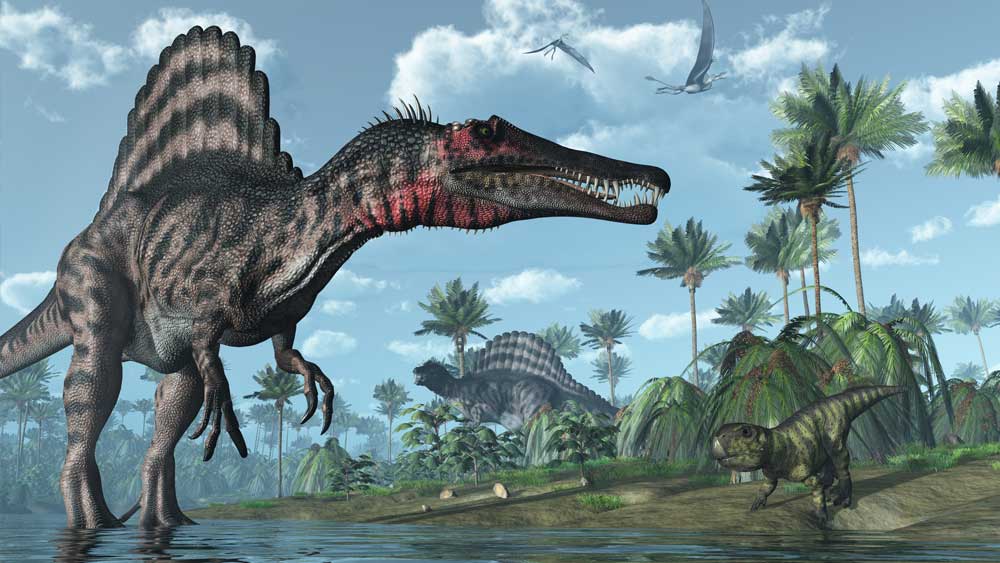Spinosaurus aegyptiacus had a longer body than the enormous T. rex. In Nature journal, researchers published a new reconstruction of the extinct reptile’s tail, showing that it would have undulated side-to-side.1 They found that the tall, flattened tail was well-suited to swimming. These newly assembled spinosaur details help reassemble its place in history.
Big-picture evolution teaches that natural processes turned fish into lizards. In this version of history, one ancestor had descendants that became all the various theropods, from the 48-foot long Spinosaurus to the turkey sized Compsognathus. If the tale holds true, then we should find theropods transitioning from some ancestral state to each of the final forms found as fossils. Instead, fossils typically show only those final forms, with no in-between versions, each fully equipped for its particular way of life.
This new spinosaur reconstruction is no exception. No transitional features—just a fully-formed tail made for swimming in every respect.
For example, most theropods had stiffened tails. Tight junctions and taut tendons tied their tail parts together for efficient land-walking strides. But the Spinosaurus tail shows no evolutionary half-measures. Small junctions and few tendons afforded it flexibility for powerful swimming. The Nature study authors even tested how efficiently its hydrodynamic shape would have served as an outboard motor for the enormous animal. Turns out, its shape is more efficient than a crocodile’s.
Back in 2018, a separate team described Spinosaurus bones as a good match to a “semi-aquatic” habitat.2 Even before then, ICR scientists noted that this dinosaur’s record-breaking skull size and water-friendly features make it a decent candidate for the Bible’s leviathan.3
God in Job and David in Psalms both referred to the leviathan as a real animal, or at least a real group that described large aquatic or semi-aquatic reptiles. The animals must have been real enough to reveal characteristics of their Maker. It swam in waters, yet left “marks in the mire” (Job 41:30)—likely shoreline muds. Imaginary creatures can’t leave visible mud tracks.
This new description of a water-friendly tail matches the creature’s other aquatic features, such as short legs. Its entire body—not just one or two still-evolving aspects—fit a whole semi-aquatic design. The Genesis description of each basic animal type reproducing according to its kind explains Spinosaurus’ uniqueness.
The Nature study authors wrote, “The near-global distribution of spinosaurids (which have now been reported from Europe, Asia, Africa, and South America).” This happens to match the Bible’s description of a global Flood. The fact that these large creatures—plus so many other land, sky, and sea creatures—turned into fossils indicates ruinous sediment-moving mayhem.
If Noah’s Flood formed these fossils, then even Spinosaurus aegyptiacus would have lived at the same time as mankind. This places God’s biblical references to such creatures into the Bible’s short timeline. If something like Spinosaurus was Job’s leviathan, then the creature lived for a time after the Flood, but has since gone extinct.
Swimming spinosaurids look more like Job’s watery leviathan than ever.
References
1. Ibrahim, N., et al. 2020. Nature. Tail-propelled aquatic locomotion in a theropod dinosaur. 581: 67-70.
2. Aureliano, T. et al. 2018. Semi-aquatic adaptations in a spinosaur from the Lower Cretaceous of Brazil. Cretaceous Research. 90: 283–295.
3. Clarey, T. 2015. Tracking Down Leviathan. Acts & Facts. 44 (7).
*Dr. Brian Thomas is Research Associate at the Institute for Creation Research and earned his Ph.D. in paleobiochemistry from the University of Liverpool.

Spinosaurus Swam! How a Swimming Spinosaurus Fits Scripture
The Latest
Puzzling Fossils at an Unlikely Time
Wherever and whenever life is found, it is incredibly complex. This certainly applies to cyanobacterial photosynthetic life that supposedly were some...
CREATION PODCAST
A Theory Designed to Be...Anti-Design | The Creation Podcast:...
Science is objective. At least, that’s what we’re told. But there are inherent issues with this statement that can...
Seeing the Case for Creation in Fruit Flies
Our brain is designed to smoothly and constantly process what we see via the incredibly sensitive photoreceptors (cones and rods) of our eyes.1...
Amazing Defense Systems
Bacteria (prokaryotes) are ubiquitous. A fraction cause disease in people, animals, and plants, but the majority are the foundation for the global food...
Octopus and Fish Plan a Complex Coordinated Hunt
The octopus—an invertebrate—never fails to surprise researchers with its incredible abilities.1,2
The octopus was designed...
A ''40 million year old'' 100% European Gnat
Finding well-preserved creatures in amber1 is a landfall for creation scientists, much like the numerous discoveries of soft dinosaur tissue...
CREATION PODCAST
The Undeniable Power of Narrative | The Creation Podcast: Episode...
Science is objective. At least, that’s what we’re told. But there are inherent issues with this statement that can cause...
Paintbrush of the Creator
Who doesn’t enjoy the amazing color patterns of butterflies?1,2 Such beautiful designs and construction do not reflect blind naturalistic...
November 2024 ICR Wallpaper
"Rejoice always, pray without ceasing, in everything give thanks; for this is the will of God in Christ Jesus for you." (1 Thessalonians 5:16-18 NKJV)
ICR...



















